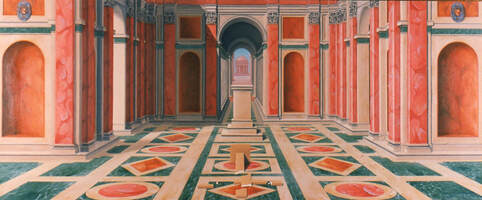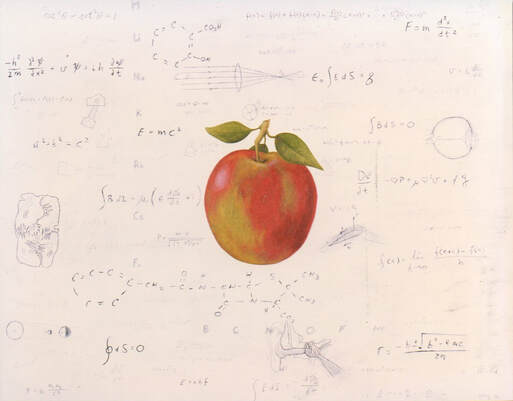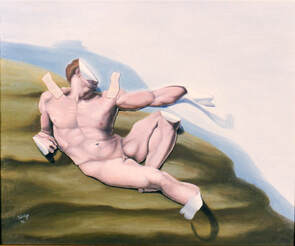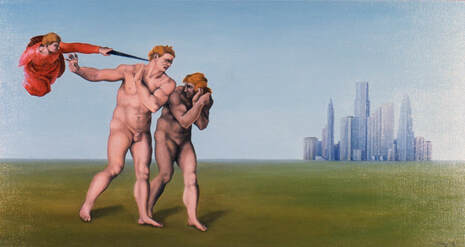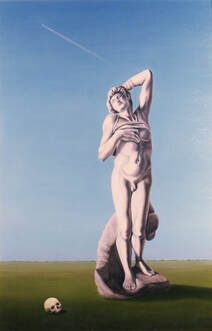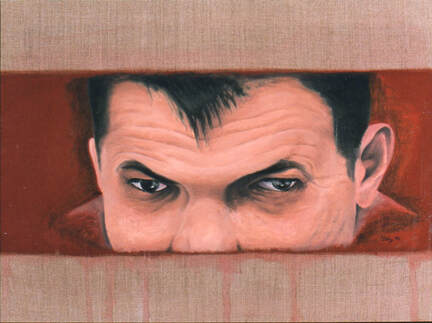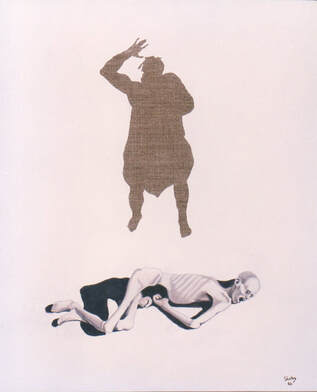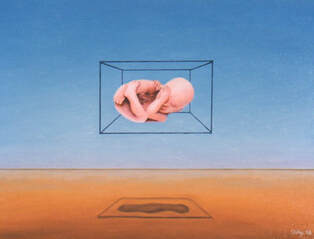GENESIS
This series of paintings on religious topics was done for a show at Archway Gallery in 1996. These paintings are highly influenced by my Catholic upbringing - a religion I later rejected as depicted in the painting Lost Faith.
I have always been fascinated by Michelangelo's images in the Sistine Chapel - the powerful figure work, the complex layout, the bright colors. It is an unparalleled achievement. The subject matter, the book of Genesis, provides the artist a unique opportunity to offer observations on the Human Condition,
This series of paintings are my thoughts on the Human Condition inspired by my readings in philosophy and using images from the Sistine Chapel. Some are my own versions of Biblical events - the creation of light, the separation of the land and sea. Some have a deeper philosophical meaning. The essence of man is a common theme to several of these paintings. But there are also thoughts on immortality, faith and the problem of evil.
My approach to art is primarily philosophical rather than decorative. I want to express my ideas on man, God, nature and art. Esthetics is often a secondary concern. Hence the presence of some unattractive raw canvas or unfinished paintings. But if you come away thinking, or even smiling, then I know I have reached you.
js, 1996
I have always been fascinated by Michelangelo's images in the Sistine Chapel - the powerful figure work, the complex layout, the bright colors. It is an unparalleled achievement. The subject matter, the book of Genesis, provides the artist a unique opportunity to offer observations on the Human Condition,
This series of paintings are my thoughts on the Human Condition inspired by my readings in philosophy and using images from the Sistine Chapel. Some are my own versions of Biblical events - the creation of light, the separation of the land and sea. Some have a deeper philosophical meaning. The essence of man is a common theme to several of these paintings. But there are also thoughts on immortality, faith and the problem of evil.
My approach to art is primarily philosophical rather than decorative. I want to express my ideas on man, God, nature and art. Esthetics is often a secondary concern. Hence the presence of some unattractive raw canvas or unfinished paintings. But if you come away thinking, or even smiling, then I know I have reached you.
js, 1996
Lost Faith is a homage to Tommaso Laureti’s "The Triumph of the Cross Over the Fallen Pagan Idol." In the original, a cross occupies the pedestal and a broken statue of Mercury is scattered on the floor. In this homage, however, it is the cross that lies fallen, but the pedestal remains empty. The broken cross symbolizes a faith that has shattered; the empty pedestal is the void left behind.
This painting shows the stereotypical image of Forbidden Fruit - the apple - surrounded by various technical diagrams and equations. When man consumed this fruit he acquired his essence - that of an intelligent being. This has led to a better understanding of himself, the universe and his place in it. The Fruit released him from his prison of ignorance into a world of discovery. In this painting, you will find samples of several scientific areas: biology (diagrams of a cell, the human eye and ear), chemistry (lists of elements from the periodic table, structural formulas for aspirin and penicillin, chemical and nuclear reactions), mathematics (Pythagorean theorem and other geometric formulas, Taylor’s theorem), and physics (Maxwell’s equations, Schrodinger’s equation, Einstein’s equation, Plank’s equation).
Paper Adam shows Adam from the Sistine Chapel’s The Creation of Adam. But here Adam appears to be peeling away from his surroundings - he is just a paper image taped to a painted backdrop. This is man before the Fall, before he bites the Fruit of the Tree of Knowledge, before he becomes a true man - one with intelligence. Without his intelligence, man is not man. The thing that lived in the Garden of Eden was no man, just another unthinking animal.
The Expulsion shows Adam and Eve from a section of the Sistine Chapel’s The Expulsion. Here, however, the Garden of Eden lies to the left, off the canvas, and on the right is a modern city (none in particular). Adam and Eve have eaten the Forbidden Fruit and have become human beings. They are leaving "paradise" and moving to a world of struggle and pain. But it is also a world of art, technology, knowledge, growth and creation. You may view the city as a positive or negative place - it has been painted vaguely to provoke either interpretation. What is important is that the city is their creation.
Immortality depicts Michelangelo’s statue “Dying Slave” on a open field, a skull at its feet and a jet contrail overhead. The skull indicates the presence of death, the statue and contrail two paths to immortality: through art and through technology. A man may die, but the work he leaves behind lives on. In this case, art occupies the central theme of the painting and we can imagine that the skull is that of the artist. The sensual nature of Michelangelo’s statue is in stark contrast to the skull and reminds us of our mortality.
This work shows the hand of God creating darkness and light. In the first panel is only the hand of God surrounded by raw canvas: the nothingness of the void. The second panel has an added black square: darkness. The last panel adds a white square: the light. The Hand of God is modeled on the Sistine Chapel's Creation of Adam.
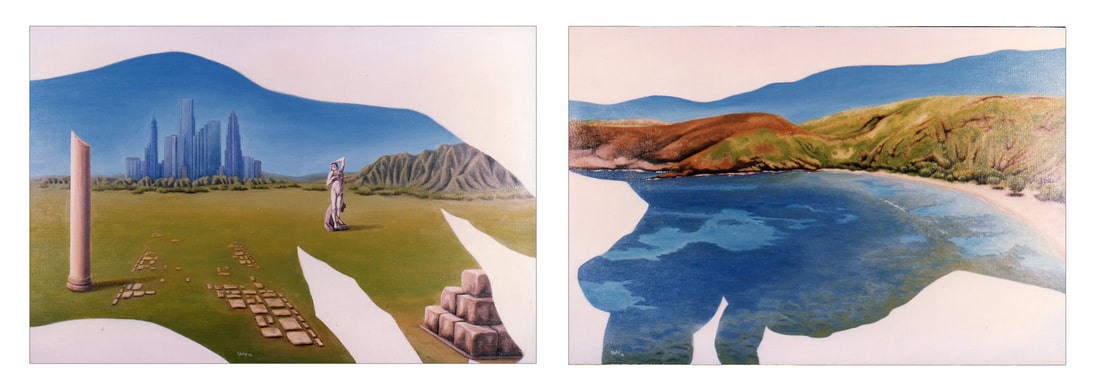 The Works of Man and God, Oil on Canvas, 24x36 each, 1996
The Works of Man and God, Oil on Canvas, 24x36 each, 1996
The Works of Man and God compare the realms of the two. On the left is a landscape, silhouetted in the image of the hand of Adam in the Sistine Chapel’s The Creation of Adam. We see an open field with mountains on the horizon. Scattered about are a pyramid, a column, a statue (Michelangelo’s Dying Slave) and a stone road pointing to a modern city. These are the works of man laid out in chronological order. They are also geometrically related to one another.
On the right panel is another landscape. This is silhouetted in the image of the hand of God from the same fresco. The landscape is Hanauma Bay in Hawaii. A finger of land juts out along the finger of God. This is the work of God, specifically the separation of the Land from the Sea.
On the right panel is another landscape. This is silhouetted in the image of the hand of God from the same fresco. The landscape is Hanauma Bay in Hawaii. A finger of land juts out along the finger of God. This is the work of God, specifically the separation of the Land from the Sea.
Cain is a portrait of the infamous figure from Genesis. It is based on a photograph of the Russian General Lebed. The raw canvas recalls The Hand of God and The Creation of Adam. The red background and red drips along with the tightly cropped close-up add evil to the image of the world’s first murderer.
|
Lost Redeemer shows a starved corpse above which is an unpainted spot in the shape of Christ the redeemer from "The Last Judgement." The corpse was drawn from a photograph of a holocaust victim. The painting symbolizes the paradox that an all-good God allows so much suffering to occur. Where is the Redeemer?
|
Original Sin is a surrealist landscape featuring a fetus in what appears to be a cage. This is a symbol of Original Sin and expresses its absurdity - that of imprisoning an innocent child. Sin cannot exist without volition. Hence man should not be guilty being what he is.
|
